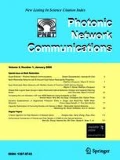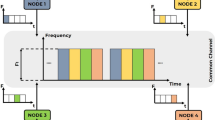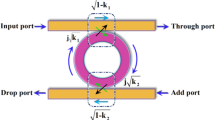Abstract
Efficient multiple-token-based MAC protocols have been proposed for optical burst-switched (OBS) unidirectional ring networks using a TT-TR-based node architecture in our previous research. However, the unidirectional OBS ring network is difficult to scale to larger networks. As wavelengths accessibilities are dominated by tokens, network performance is restricted by the frequency of capturing a token. If the network is too large, it takes a long time for tokens to rotate. Thus, a destination queue may wait for a long time to be served, which results in large queuing delays and inefficiency of network resource utilization. In order to improve network efficiency and scalability for OBS ring networks using multiple tokens, this work is extended to a bidirectional ring system that uses the tunable transmitter and tunable receiver (TT-TR)-based node architecture with two pairs of transceivers, so that each queue can be served by tokens from both directions. Furthermore, two kinds of node architectures differing in sharing the two pairs of transceivers, either shared or not, are proposed. Then, two MAC protocols considering different queue scheduling algorithms are proposed for the ring network using the proposed node architectures, in order to use the network resources more efficiently. They are improved from general round-robin (GRR) and termed as half-ring round-robin (HfRR) and co-work round-robin (CoRR), respectively. The network performance of the two proposed node architectures and the two proposed MAC protocols for the networks using them as well as the network scalability are evaluated with the OPNET simulator.
Similar content being viewed by others
References
Odlyzko, A.M.: Internet traffic growth: sources and implications. Optical transmission systems and equipment for WDM networking II, Orlando Florida, proceedings of SPIE, vol. 5247, pp. 1–15 (2003)
Internet Growth Statistics, http://www.internetworldstats.com/
Jeiger C.S., Elmirghani J.M.H.: Photonic packet WDM ring networks architecture and performance. IEEE Commun. Mag. 40(11), 110–115 (2002)
Bengi K.: Access protocols for an efficient and fair packet-switched IP-over-WDM metro network. Comput. Netw. 44(2), 247–265 (2004)
Francini A., Chiussi F.M., Clancy R.T., Dtucker K.D., Idirene N.E.: Enhanced weighted round robin schedulers for accurate bandwidth distribution in packet networks. Comput. Netw. 37(5), 561–578 (2001)
Qiao C., Yoo M.: Optical burst switching (OBS)—a new paradigm for an optical internet. J. High Speed Netw. 8(1), 69–84 (1999)
Turner J.S.: Terabit burst switching. J. High Speed Netw. 8(1), 3–16 (1999)
Xiong Y., Vandenhoute M., Cankaya H.C.: Control architecture in optical burst-switched WDM networks. IEEE J. Sel Areas Commun. 18(10), 1838–1851 (2000)
Xu J., Qiao C., Li J., Xu G.: Efficient burst scheduling algorithms in optical burst-switched networks using geometric techniques. IEEE J. Sel. Areas Commun. 22(9), 1796–1881 (2004)
Battestilli T., Perros H.: An introduction to optical burst switching. IEEE Commun. Mag. 41(8), 10–15 (2003)
Gauger, C., Dolzer, K., Späth, J., Bodamer, S.: Service differentiation in optical burst switching networks. In: Proceedings of ITG-Fachtagung Photonic Networks, Dresden, Germany, pp. 124–132, March 12–13 (2001)
Xu L., Perros H.G., Rouskas G.N.: A simulation study of optical burst switching and access protocols for WDM ring networks. Comput. Netw. 41(2), 143–160 (2003)
Arakawa, Y., Yamanaka, N., Sasase, I.: Performance of optical burst switched WDM ring network with TTFR system. In: Proceedings of 1st IFIP Optical Networks & Technologies Conference (OpNeTec), Pisa, Italy, pp. 95–102 (2004)
Peng, L.M., Kim, Y.C., Yoo, K.M., Han, K.E., Kim, Y.C.: Design and performance evaluation of token-based MAC protocols in WDM burst switched ring networks. In: Proceeding of International Conference Distributed Computing and Internet Technologies, Bhubaneswar, India, pp. 21–26 (2005)
Peng L.M., Yoo K.M., Kim Y.C.: Design and performance comparison of multiple-token based MAC protocols for optical burst switched ring networks. Photonic Netw. Commun. 15(3), 213–225 (2008)
Peng, L.M., Li, B.B., Yang, W.H., Kim, Y.C., Li, X.W.: Novel queue-grouping based round-robin protocols for reducing collision of OBS ring networks. In: Proceeding of Fifth International Conference on Networking and Services, Valencia, Spain, pp. 97–101 (2009)
Peng L.M., Kim Y.C.: Investigation of the Design of MAC Protocols for TT-TR-based WDM Burst-Switched Ring Networks. J. Opt. Commun. Netw. 1(2), A25–A34 (2009)
Author information
Authors and Affiliations
Corresponding author
Rights and permissions
About this article
Cite this article
Peng, LM., Yang, WH. & Kim, YC. On the design of node architectures and MAC protocols for optical burst-switched ring networks. Photon Netw Commun 21, 267–277 (2011). https://doi.org/10.1007/s11107-010-0298-3
Received:
Accepted:
Published:
Issue Date:
DOI: https://doi.org/10.1007/s11107-010-0298-3




